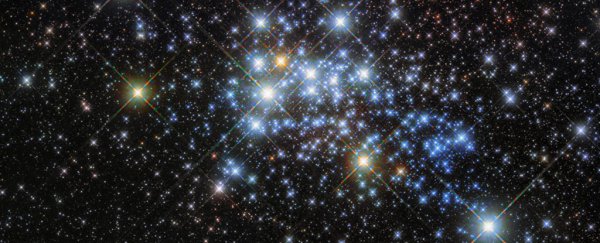For the first time, the Hubble telescope has zoomed in on Westerlund 1, a beautiful cluster that houses one of the largest stars in the Milky Way.
The red supergiant Westerlund 1-26 (W26) is so huge that if it were in the centre of our Solar System, it would encompass all four rocky planets, and extend beyond the orbit of Jupiter.
Named after Swedish astronomer Bengt Westerlund, who first spotted the "heavily reddened cluster" in the Southern Hemisphere sky in 1961, the cluster is located in the Ara constellation - one of the 48 constellations Greek astronomer Ptolemy listed way back in 2nd century AD.
Classified as a 'super star cluster', Westerlund 1 lies only about 15,000 light-years away from us, which is quite close in astronomical terms.
Still, it doesn't feel that close when you realise that the light captured by Hubble in the photo above left the stars about the same time as when humans first entered North America during the last Ice Age.
The beautiful collection of stars is among the most massive star clusters in our galaxy, and contains many exceptionally luminous objects. It is thought that the cluster formed in one large burst of stellar activity, which means most of the stars have similar ages and compositions.
Among the more massive objects Westerlund 1 contains are six yellow hypergiants, four red supergiants (including the enormous W26), and 24 particularly rare objects called Wolf-Rayet stars, which can be up to a million times brighter than the Sun.
If that's not enough to make Westerlund 1 special, it also contains a luminous blue variable - an extremely rare type of star that's characterised by unpredictable changes in its brightness.
These stars are so rare, we only know of about a dozen across our entire Milky Way.
To get back to our star attraction, W26 sports an exceptional size of about 1,530 Solar radiuses (star size is measured against our own Sun, naturally). The red supergiant is thought to be so big, it easily sits within the top 5 of the biggest stars we've ever found.
The current top spot in that ranking is taken up by UY Scuti, also a red supergiant found in the Scutum constellation - it's 1,708 Solar radiuses wide, give or take 192.
Despite its many charms, the cluster is pretty much a collection of stellar babies, as the whole thing is only a few million years old. For comparison, our Sun has already clocked a respectable 4.6 billion years.
But because the stars in Westerlund 1 are so massive, their lifespans will inevitably end up shorter than those of their smaller counterparts. In 2013, astronomers announced that W26 is already nearing the end of its life.
"Stars with masses tens of times larger than that of the Sun live very short and dramatic lives compared to their less massive siblings," states the UK's Royal Astronomical Society.
"Some of the most massive stars have lifetimes of less than a few million years before they exhaust their nuclear fuel and explode as supernovae."
For now, we can still gaze in wonder at W26 and its neighbours.
This latest image was made from both the visible and infrared data captured by Hubble's Wide Field Camera 3. As with any astronomy shot, brighter doesn't necessarily mean bigger, which makes it tricky to figure out which of the bright dots is W26.
But we're here to help. According to astronomer Alan Duffy from Swinburne University, it's most likely the bright orange star towards the centre-left of the photo:
oooo good question, I believe it's the centre object a little left pic.twitter.com/GqFasji6CY
— Alan Duffy (@astroduff) March 20, 2017
For more wonderful postcards from Hubble's travels, check out NASA's website.
